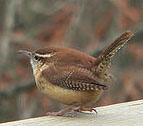 Known for their loud songs and friendly ways, wrens are familiar backyard birds in most parts of the United States with House wrens being the most common. Members of the Wren family vary is size and habits but most are brownish and have some barring espceially to the tail and/or wings. Their bodies are plump, their legs are thin and strong, their wings are short, and their long pointy beaks are adapted for pulling insects out of tight places. Some species hold their tails upright. Wrens eat insects, spiders, and other arthropods and especially like beetles, millipeds, sow bugs, stinkbugs, grasshoppers, and caterpillars. Some wrens eat lizards, snails, and tree frogs while others enjoy berries especially when insects are lacking. Like other insectivorous birds, wrens migrate in response to insect availability.
Known for their loud songs and friendly ways, wrens are familiar backyard birds in most parts of the United States with House wrens being the most common. Members of the Wren family vary is size and habits but most are brownish and have some barring espceially to the tail and/or wings. Their bodies are plump, their legs are thin and strong, their wings are short, and their long pointy beaks are adapted for pulling insects out of tight places. Some species hold their tails upright. Wrens eat insects, spiders, and other arthropods and especially like beetles, millipeds, sow bugs, stinkbugs, grasshoppers, and caterpillars. Some wrens eat lizards, snails, and tree frogs while others enjoy berries especially when insects are lacking. Like other insectivorous birds, wrens migrate in response to insect availability.
Wrens tend to like low vegetation and can be found in a large variety of habitats especially where there are many shrubs that attract insects, and provide berries and cover.
 Serviceberry (Amelanchier cultivars and hybrids)
Serviceberry (Amelanchier cultivars and hybrids)
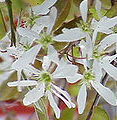 White flowers appear in early spring before the leaves on this deciduous shrub or small tree native to North America. In the fall blueberry like fruits follow the flowers and the leaves turn red, organge, and purple. Serviceberry is especially pleasing planted in a group and will provide fruit for wrens such as the house wren and Carolina wren as well as other berry eating birds including orioles, tanagers, thrushes, and waxwings. Warblers and vireos like the insects that are attracted to the flowers.
White flowers appear in early spring before the leaves on this deciduous shrub or small tree native to North America. In the fall blueberry like fruits follow the flowers and the leaves turn red, organge, and purple. Serviceberry is especially pleasing planted in a group and will provide fruit for wrens such as the house wren and Carolina wren as well as other berry eating birds including orioles, tanagers, thrushes, and waxwings. Warblers and vireos like the insects that are attracted to the flowers.
Size: 15-30′ depending on the variety
Site: Full sun to part shade; medium moist, well-drained soil
Hardiness: Zones 4-9 depending on the variety
 Burning Bush (Euonymus altus)
Burning Bush (Euonymus altus)
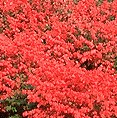 Known as burning bush because of its bright red foliage in fall, this deciduous shrub is also known for the corky ridges on its stem that look like wings. Small flowers are produced over a long bloom period is spring and are followed by small pink to orange berries. Burning bush provided cover, insects from the flowers and foliage, and fruit for the wrens.
Known as burning bush because of its bright red foliage in fall, this deciduous shrub is also known for the corky ridges on its stem that look like wings. Small flowers are produced over a long bloom period is spring and are followed by small pink to orange berries. Burning bush provided cover, insects from the flowers and foliage, and fruit for the wrens.
Size: 6′ H
Site: Full sun to part shade; medium moist, well-drained soil
Hardiness: Zones 5-9
 Cholla Cactus (Opunta spp.)
Cholla Cactus (Opunta spp.)
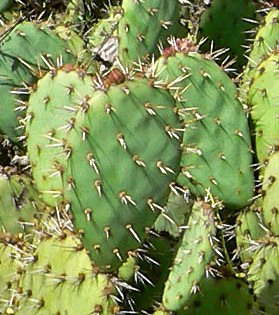 An excellent option for desert gardens where western wrens are found, this spiny plant is also know as prickly pear and has showy flowers and waxy fruit. It provides wrens with nesting sites, cover, and fruit for food. Mimic thrushes and gallinaceous birds may also find the fruit attractive.
An excellent option for desert gardens where western wrens are found, this spiny plant is also know as prickly pear and has showy flowers and waxy fruit. It provides wrens with nesting sites, cover, and fruit for food. Mimic thrushes and gallinaceous birds may also find the fruit attractive.
Size:3- 20′ depending on the s pecies
Site:Full sun; dry, well-drained soil
Hardiness: Zones 4-11 depending on the species
 Autumn-blooming Clematis (Clematis terniflora)
Autumn-blooming Clematis (Clematis terniflora)
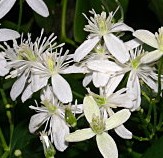 This deciduous fast growing vine produces and mass of stems and leaves in spring and an abundance of small, white,fragrant flowers in late summer to fall. Wrens use the plants for cover, roosting, and nesting. This clematis can be grown on a trellis, arbor or fence, or allowed to spread on the ground as a ground cover.
This deciduous fast growing vine produces and mass of stems and leaves in spring and an abundance of small, white,fragrant flowers in late summer to fall. Wrens use the plants for cover, roosting, and nesting. This clematis can be grown on a trellis, arbor or fence, or allowed to spread on the ground as a ground cover.
Size:To 30′ long
Site: Full sun to part shade: medium moist, well-drained
Hardiness: Zones 5-9
 Strawberry (Fragaria spp and hybrid)
Strawberry (Fragaria spp and hybrid)
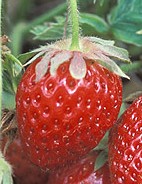 Enjoy the strawberry fruits of Fragaria × ananassa along with wrens who find them irresistible or opt for wild strawberries. Other birds including thrushes and tohees enjoy the berries too. The perennial plants are attractive and make a good ground cover
Enjoy the strawberry fruits of Fragaria × ananassa along with wrens who find them irresistible or opt for wild strawberries. Other birds including thrushes and tohees enjoy the berries too. The perennial plants are attractive and make a good ground cover
Size:6″ H
Site:Sunny; medium moist, well-drained soil
Hardiness: Zones 4-9
 Broccoli (any variety)
Broccoli (any variety)
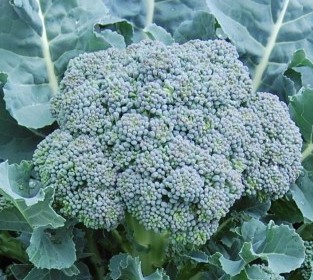 If you don’t grow broccoli in your vegetable garden consider planting a few plants in a flower bed or border. Both adult cabbage white butterflies and their caterpillers are found on the plants and make a feast for wrens. Many other birds such as flycatchers, vireos, cardinals, chickadees and titmice eat the butterlies and their caterpillars like the wrens, while other birds including sparrows, towhees, and doves, enjoy the seeds,
If you don’t grow broccoli in your vegetable garden consider planting a few plants in a flower bed or border. Both adult cabbage white butterflies and their caterpillers are found on the plants and make a feast for wrens. Many other birds such as flycatchers, vireos, cardinals, chickadees and titmice eat the butterlies and their caterpillars like the wrens, while other birds including sparrows, towhees, and doves, enjoy the seeds,
Size: 2-3′ H
Site: Full sun; medium-moist, well-drained soil
Hardiness: Annual